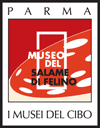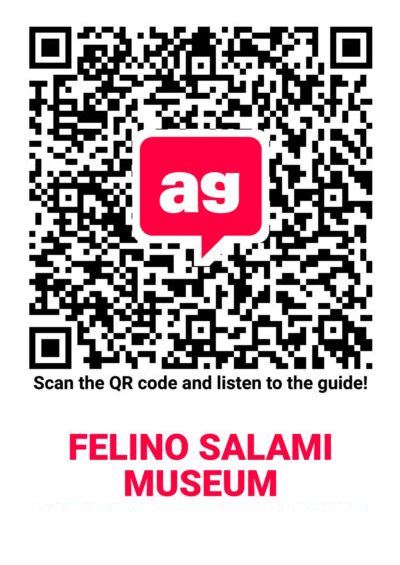Questo servizio è stato realizzato grazie al sostegno di Fondazione Cariparma

The Felino salami Museum is hosted in the cellars of the Castle of Felino. The “Castrum Filini” is documented from the 12th century on, but probably existed before that time. It was enlarged and fortified, reaching its maximum splendor under Pier Maria Rossi in the 1400s. The ancient manor controlled the communication roads between the valleys of the torrents Parma and Baganza. It became a possession of the Bishop of Parma, and it was sold to private owners in the 20th Century. Today, it hosts a charming restaurant. The Salami Museum is organized in five sections. The visit begins with a section showing historical documentation which testify to the relationship between Felino and the product for which it has been famous throughout the centuries, including the story of the famous black pig of Parma.
The absolute symbiosis between Felino and swine dates back to the bronze age, as documented by bone fragments found among the archeological artifacts from the Monte Leoni village, located on the hills above the town village.
In the II century B.C. Polibius notes how the majority of swine butchered in Italy and used in private use and for military food supplies came from the Plain of Padana, so rich in oak trees and acorns.
In Roman times several types of pork meat cold cuts were documented, all with different tastes and different types of casing. Later, the barbaric tribes of Celtic and Lombard descent contributed to make cold cuts one of the main culinary protagonists in their traditions.
Important iconographic documents have been found in the Parma Area dating from the Middle Ages. Sculptors from the period documented the butchering of swine to make cold cuts in the “cycles of months” or “zodiac” representations found in many Romanic churches. In the Fidenza and Parma cathedrals there are representations of the killing of a pig. In the Parma Baptistery the plaque of the zodiac sign of Aquarius shows salami left to dry next to a fire. This relationship has continued to develop up to modern times. In the 19th Century, twelve salami manufacturers were active in the Felino territory, and the importance of this processing work was such that the laws protecting public health became more and more numerous and restrictive, giving increasingly detailed descriptions of quality controls and prohibitions. At the beginning of 1900s these laws were important for the recognition of the Felino trademark as a symbol of wholesome goodness and quality of the salami produced in the area.
The swine raised up until the 1800s was small, black and had very tasty meat. It roamed free in the woods and fed on acorns – the fruit of oak tree. This kind of feeding gave an unmistakable and somewhat characteristic aroma to its meat, and therefore to the cold cuts as well. Only at the end of the 1800s were other varieties of animals imported from England. Their size was much larger and their growth rate faster. The black swine of Parma, less productive and less economically profitable than the English races, risked disappearing. In recent times, it was saved thanks to long research and has since been reintroduced into the habitat. Today black swine cold cuts of the highest quality are produced, allowing us to taste the flavor of the past.
If we exclude the artistic representations, the first document or act relative to salami found in Parma dates from 1436, when Niccolò Piccinino, a soldier in the service of the Duke of Milan who was headquartered in this area, ordered that ‘pòrchos vigìnti a càrnibus pro sallàmine’ that is “twenty pigs suitable to make salami” be found for him. In the Italian language lexicon, the word salami can be found starting from 1542 and it is thought that the term derives from the medieval Latin term salàmen which means “a mix of salty foods”.
It’s not a coincidence that the section of the museum dedicated to gastronomy is located in the castle’s former kitchen halls. It shows reproductions of paintings which witness the use of salami in gastronomy in Parma. Salami, up to the 17th century, was eaten prevalently cooked, like all other cold cuts. The cooked shoulder, the Cotechino and the Salama of Ferrara used to make sauce are “historical remnants” of that antique system. Following the improvement of hygienic conditions, starting form the 17thcentury the use of raw cold cuts spread, as documented by several still life paintings presented in this exhibit. Salami was considered the most precious of cold cuts, and rightfully earned the privilege to be used in the centerpiece decoration for the marriage of Giulio Thieni, Count of Scandiano near Reggio Emilia, and Anna Eleonora Sanvitale of Sala Baganza, near Parma.
Moreover, a singular example of integration between the production and the use of salami in a farm owned by the Jesuit Fathers is documented, as the priests would usually offer their production of salami to important Roman prelates, since these cold cuts were considered to be of high value.
The visit continues in the large hall, where a section dedicated to butchery and to home made salami production is located. A video presenting some photographic sequences narrating all of the phases of the ritual of “killing” can be seen. In the glass cabinets, a large collection of objects which belonged to butchers and to the farming families of the area can be found. Among these, in particular, on the right side of the room there is a “butcher’s cloak”.
The butcher is the person who has the knowledge and the competence to kill swine. The word “norcino” derives from the town of Norcia in Umbria, since originally these workers came from that area, travelling in the winter season to reach all locations in Italy to butcher swine. The pig owes its name to Maia, the goddess of abundance and of money boxes, traditionally shaped like a small piglet. The butcher was a travelling professional who brought his tools with him, going from family to family, from farm to farm. Because of the great respect that the farming culture had for the figure of the pig, it was killed by means of a stiletto stroke to the heart, so that the animal would not suffer. The “coradòr” or heart knife, which can be seen next to the butcher’s basket, was used. Then, the pig was washed in boiling water, and moved on a cart or sled, an example of which can be seen in the center of the room. It was hung on a fork, shown on the left side of the room, and then it was cut in half, and later sectioned.
Every part of the pig was destined for the production of a specific cold cut. The anterior leg was used for Spalla; the hind leg for prosciutto, or, in the low planes, for Culatello and Fiocchetto. The fat under the skin became precious lard, the meat under the throat was used in the mix to make cotechino and zampone; the belly was used for Pancetta; the upper part of the neck became coppa. The lean meat was ground and used as the base of the mix to make salami. In the right hand section of the room some simple tools used to make salami can be seen – a meat grinder, which could also be used to pack sausages, some needles, cord, and a hand made stuffing machine used to easily fill gut with the meat mix.
History has handed us the saying that “not one part of pork meat is wasted” and truly in the rural economy every part of the animal had its function, even the hair, which was used for the bristles of brushes. Anything which was left over, after the internal organs, the nails and the hair were taken away, was used to make another cold cut called cicciolata. Two examples of cicciolatapresses can be seen in the museum, one is located in the kitchen and the other in the following room in the exhibit.
The next room presents the production technology, describing the main characteristics from the origins to the pre-industrial period, up to contemporary technology, with the “identity card” of the modern product. Centered in the room like a throne, there is a large red stuffing machine for salami used in one of the first industries in the Felino area. In this section can be found information about the sale and commercial aspects of Salami of Felino dating back to the 1700s. Salami of Felino was made according to a series of precise steps. The gourd meat was mixed
with salt and seasoning, and wet with white wine. In the Salami of Felino pepper is used as well, a rare and expensive spice which tells us the commercial and gastronomic value given to this product throughout the centuries. After the seasoning, the mix was put into the stuffing machine and used to fill the casing. Salami had to quickly dry next to a fire or in another warm room. After a few days of drying, they were brought into the cellar to be dried. The processing took place during the coldest time of the year, since there were no other methods of food storage, the cold occurring in winter had to be taken advantage of.
The last room is dedicated to the Museum’s video, which shows highlights evoking the ancient technique of production, followed by a sequence dedicated to modern production.
Proceeding back towards the entrance, in the large hall, the panels on the left side present some curious facts about salami through documents and images. For example, the story of the army of the Duke of Parma, whose soldiers, who were more engaged in eating than in fighting, had been nicknamed “salamari” or salami eaters, or the humor of Guillaume Du Tillot, prime minister of the Duke of Parma in the second half of 1700s who, when given the title of Marquis of Felino, said that he had become the “head of a town of salami”.
And at last, we must remember that in the Parma dialect the pig had two names: when alive, it was called “gosé” and when it was dead it was called “al nimel”, the animal per excellence, which could insure the survival of a farming family even through the years of famine.
The visit to the museum ends appropriately with the sampling of a salami based menu at the charming restaurant in the Castle.



